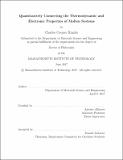Quantitatively connecting the thermodynamic and electronic properties of molten systems
Author(s)
Rinzler, Charles Cooper
DownloadFull printable version (2.025Mb)
Other Contributors
Massachusetts Institute of Technology. Department of Materials Science and Engineering.
Advisor
Antoine Allanore.
Terms of use
Metadata
Show full item recordAbstract
The electronic and thermodynamic properties of noncrystalline systems are investigated and quantitatively connected through the application of theory presented herein. The electronic entropy is confirmed to control the thermodynamics of molten semiconductors. The presented theory is applied to predict the thermodynamic properties of the prototypical Te-Tl molten semiconductor from empirical electronic property data and the electronic properties from empirical thermodynamic data. The theory is able to answer a question posed in the literature regarding a correlation between features of phase diagrams and molten semiconductivity. The quantitative connection is extended to predict thermodynamic properties of fusion, and a stability criterion to predict whether a system will behave as a molten semiconductor is developed and verified. The investigation and prediction of electronic transitions, such as metallization of high temperature systems, is enabled by the theory provided herein. The thermodynamic bases for key features of phase diagrams in the molten state are explained and quantified. Methods to rapidly collect electronic and entropy data in the molten phase are provided and enable access to key thermodynamic data for high temperature systems. The connection of electronic entropy to short-range order allows the detection and prediction of solid-phase compounds through the collection of electronic property data in the molten phase and the prediction of thermodynamic quantities of fusion. An absolute reference for entropy at temperatures substantially above 0! K is proposed.
Description
Thesis: Ph. D., Massachusetts Institute of Technology, Department of Materials Science and Engineering, 2017. This electronic version was submitted by the student author. The certified thesis is available in the Institute Archives and Special Collections. Cataloged from student-submitted PDF version of thesis. Includes bibliographical references.
Date issued
2017Department
Massachusetts Institute of Technology. Department of Materials Science and EngineeringPublisher
Massachusetts Institute of Technology
Keywords
Materials Science and Engineering.